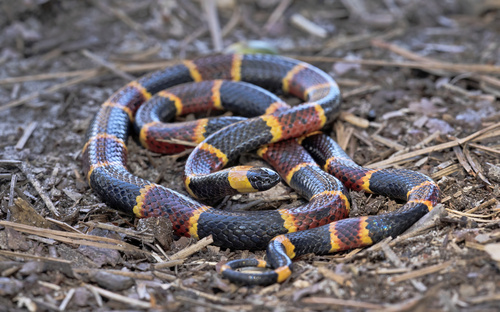
Eastern Coral Snake
The Eastern Coral Snake, with its striking red, yellow, and black bands, is a secretive inhabitant of southeastern U.S. forests. Known for potent venom and solitary, nocturnal behavior, this elusive snake plays a crucial role in controlling small prey populations, contributing to ecological balance.
7 years
Lifespan
Length: 61 - 91 cm
Size
Yellow, Red, Black, White
Color
Low
Aggression
Least Concern
Conservation Status
Stable
Population Trend
Characteristics
Micrurus fulvius, commonly known as the Eastern Coral Snake, features vibrant red, yellow, and black banding. It inhabits the southeastern United States in wooded or scrub areas. Despite being shy and elusive, its potent neurotoxic venom is a notable defense mechanism. Prefers solitary, nocturnal habits.
Distribution Range of the Eastern Coral Snake
Micrurus fulvius, commonly known as the Eastern Coral Snake, is native to the southeastern United States. Its geographical distribution includes the states of North Carolina, South Carolina, Georgia, Florida, Alabama, Mississippi, and parts of Louisiana. The species is primarily found on the coastal plains and lower Piedmont regions.
Eastern Coral Snake's Habitat
Environmental Conditions
The Eastern Coral Snake inhabits environments with warm, humid climates typical of the southeastern U.S. It thrives in areas with sandy soil where it can easily burrow. The species is commonly found in pine and scrub oak sandhills, hardwood forests, and near wetlands. It may also inhabit residential areas with suitable cover and prey availability.
Ecological Niche
Micrurus fulvius occupies a niche as a specialist predator, primarily feeding on smaller snakes, lizards, and occasionally frogs. Its secretive and fossorial nature allows it to avoid predators and extreme weather conditions. The snake is adapted to a life spent mostly underground or under cover, emerging mainly during cooler parts of the day or during periods of high humidity.
Copyright @ Nature Style Limited. All Rights Reserved.
 English
English